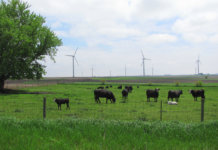 President Barack Obama has officially signed H.R.8, the American Tax Payer Relief Act, into law. While the sweeping legislation helped extend unemployment insurance and make permanent the Bush-era tax cuts, it also extended for one year the wind energy production tax credit (PTC), as well as the investment tax credit (ITC), which is important for offshore and community wind.
President Barack Obama has officially signed H.R.8, the American Tax Payer Relief Act, into law. While the sweeping legislation helped extend unemployment insurance and make permanent the Bush-era tax cuts, it also extended for one year the wind energy production tax credit (PTC), as well as the investment tax credit (ITC), which is important for offshore and community wind.
Per the legislation, wind energy projects must begin construction by Jan. 1, 2014, in order to receive the $0.022/kWh incentive. Notably, the act amends the ‘in-service’ date to a ‘begin construction’ date, which allows for more lead time for developers than would a one-year extension alone.
Although the extension averts a total collapse this year, wind developers (and likely manufacturers) are still grappling with a host of issues. Chief among those concerns is the true definition of ‘begin construction.’
According to Keith Martin, partner at Chadbourne & Parke, the Internal Revenue Service (IRS) needs to decipher for the industry what it means for a project to be under construction in order to qualify for the PTC or the ITC. The IRS issued a similar clarification on so-called ‘begin construction’ language after the issuance of the U.S. Department of the Treasury's Section 1603 cash-grant program.
Martin says geothermal industry lobbyists who pushed for the change in language to "start construction" talked to the Senate tax committee staff about using the same approach that was used for Treasury cash grants.
‘The grant program has an unusually generous definition of what it means to start construction,’ he says, noting that the issue for wind farms is that each turbine is considered a separate ‘facility’ for tax purposes.
‘Among the issues the IRS will have to decide is whether to give developers the option to treat an entire wind farm as a single facility for this purpose so that the start of construction of one turbine will be considered the start of work on the entire project," Martin adds.
The IRS has typically taken up to one year to resolve discrepancies. However, given that the wind industry only has a one-year extension, the IRS could expedite a ruling within four to six months, Martin says.
However, the government's track record in this area has been less than stellar. The Section 1603 cash grants were included as part of the American Recovery and Reinvestment Act of 2009, which Obama signed into law on Feb. 17, 2009. However, it was not until July 9, 2010 – nearly 18 months later – that the Treasury provided guidance relating to the 5% safe harbor for the start of construction.
David Burton, partner at Akin Gump Strauss Hauer & Feld, says the act's "begin construction" language may mean incurring 5% of the cost in 2013, which is how the Treasury interpreted the begin-construction rules for the Section 1603 cash-grant program.
Just the same, the Treasury or the IRS will need to rule on the interpretation, Burton says, adding that the Joint Committee on Taxation, a group of tax lawyers that advise the Senate Finance Committee, could help to clarify the matter in a few weeks.
As written, Burton says, the act does not include an end date. Therefore, savvy project developers could theoretically bank tax credits well into the future. For example, a wind farm owner could incur $5 million to purchase wind blades in 2013 and use those blades in a $100 million project that is completed in 2017. As currently written, the wind project would be eligible for 10 years of PTCs beginning in 2017.
According to Burton, if a developer plans well and banks enough 2013 PTC-eligible component parts, it may be able to continue to construct PTC-eligible wind farms indefinitely.
However, he cautions, ‘We do not know yet if the government will permit such an interpretation.’
And without the certainty, wind developers are unlikely to take full advantage of the extension.
‘The regulations interpreting the new PTC/ITC language have not been issued yet, so we can't be sure,’ notes Jeff Grybowski, CEO of Deepwater Wind, the developer behind the 30 MW Block Island Wind Farm. ‘We intend to qualify the Block Island Wind Farm for the tax credits this year, assuming the regulations permit it.’



